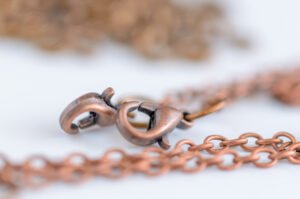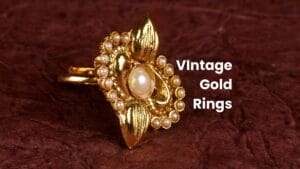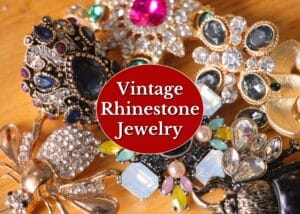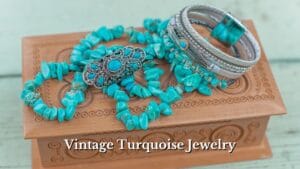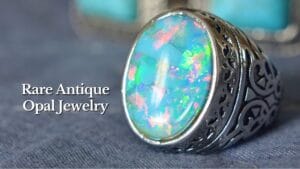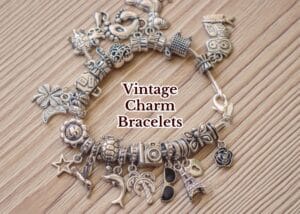Everyone knows about expensive diamonds and gold, but most people ignore vintage jewelry with precious stones! Like coral – the warm, red-orange stone you might’ve seen in pendants, brooches, and even rings!
Vintage coral jewelry looks innocent enough, but it actually brings in ridiculous money at auctions and sales, and we’re talking thousands here!
In this guide, I’m going to show you exactly which coral jewelry pieces are worth your attention (and money) and how to know whether they’re real or not!
Why Is Coral Jewelry & Why Is It Valuable?
Coral jewelry is made from the skeletal remains of tiny sea creatures called marine polyps. These little animals secrete calcium carbonate to build those intricate, branching structures found on the ocean floor.
What makes coral so rare is how incredibly slowly it grows – maybe a few millimeters per year – and it lives way down in the deep ocean where it’s tough to harvest. Plus, not all coral can be turned into jewelry. Only “precious coral” (mostly from the Corallium genus) has the right qualities for making beautiful pieces.
Coral has been treasured for thousands of years across different cultures. For instance, ancient Egyptians buried it with the dead to keep evil spirits away, Romans put it on their kids for protection, and Victorians saw it as a symbol of good fortune.
In Italy, red coral is believed to protect against the “evil eye” and help with fertility. This rich history is part of why coral jewelry is so collectible today, especially vintage pieces!
11 Highly Valuable & Rare Coral Jewelry Pieces to Find Now!
Let’s take a look at some of the rare vintage coral pieces that have sold for premium prices, and we’re not talking a few bucks, but thousands!
1. Art Deco Platinum Coral & Diamond Jabot Pin
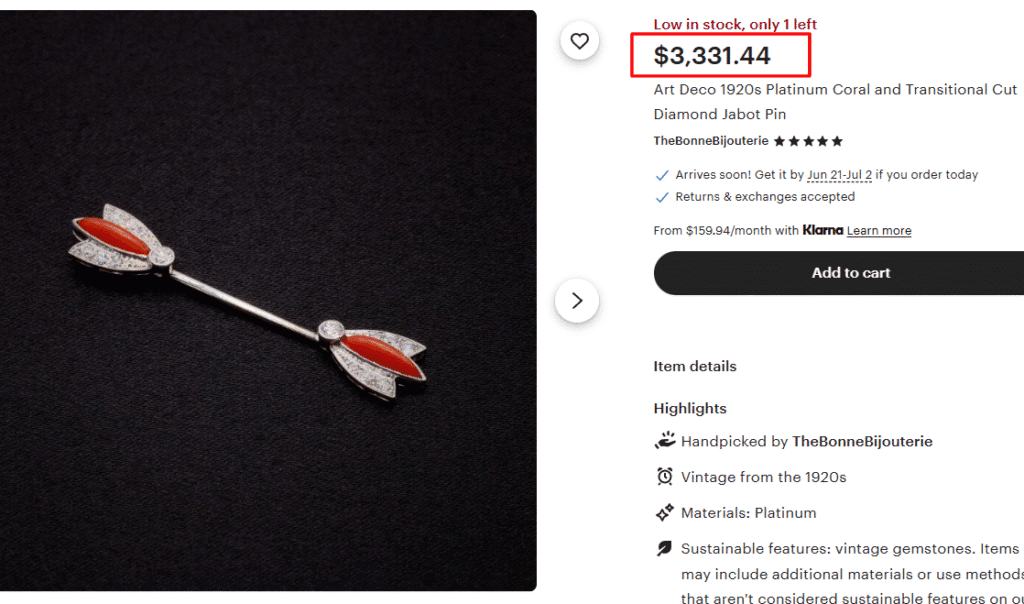
This is a rare Art Deco jabot pin from the 1920s featuring transitional cut diamonds and carved coral elements set in platinum – a super collectible combination that can be worth up to $2,000 to $5,000 in excellent condition!
The combination of coral with diamonds in platinum also shows the era’s love for mixing organic materials with precious metals! The geometrical design of this pin also speaks for its Art Deco artistry!
2. Hand-carved Renaissance Revival Coral Gold Pendant
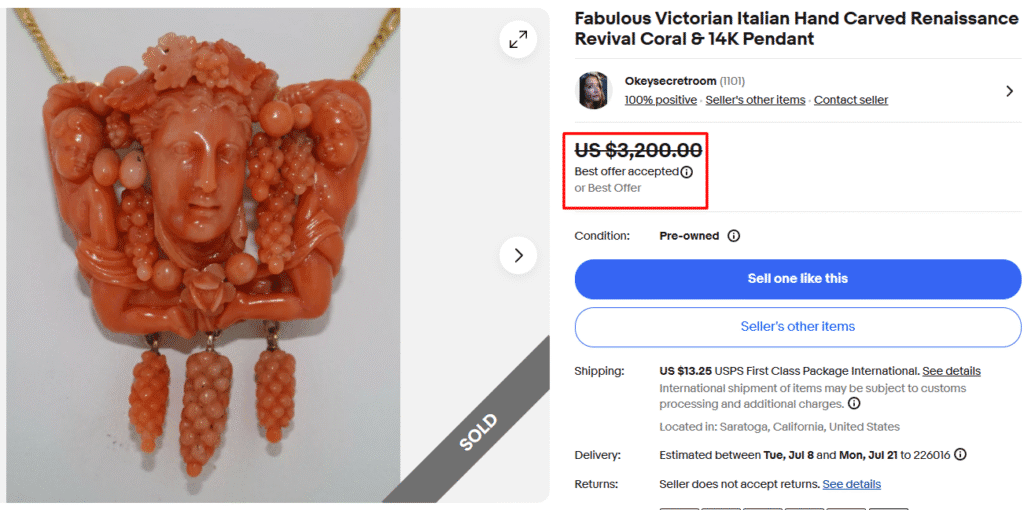
A true example of Italian Renaissance Revival artistry from the Victorian era, this intricate hand-carved coral pendant features multiple figures and classical motifs, surrounded by delicate coral bead drops.
The 14k gold mounting also shows fine Etruscan Revival influence with detailed beadwork and granulation. This museum-quality piece sold for a stunning price of over $3,200, which is justified by its exceptional three-dimensional carving and preservation!
3. Memento Mori Skulls Diamond & Coral Ring
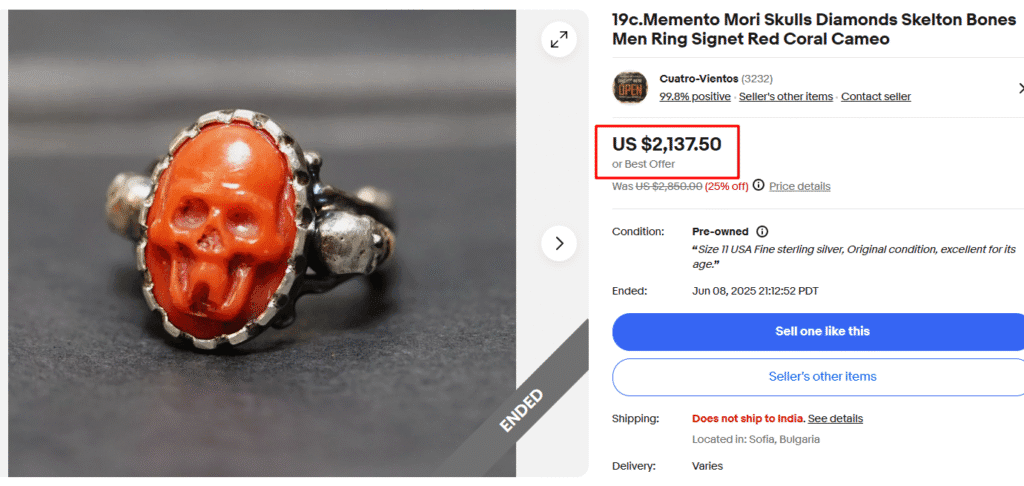
This “haunting” ring brings to you the Victorian fascination with memento mori jewelry — literally “remember you will die.” It features a finely carved red coral skull sitting in a sterling silver mounting with skeleton bone details and diamonds inside the tiny dents on the frame’s edge!
These pieces, especially with coral, were popular during the Gothic Revival period and are incredibly rare today. Depending on frame material and additional gemstones, this ring can fetch $500-$3,000 or more!
4. Navajo Henry Sam Sterling Mediterranean Coral Bracelet
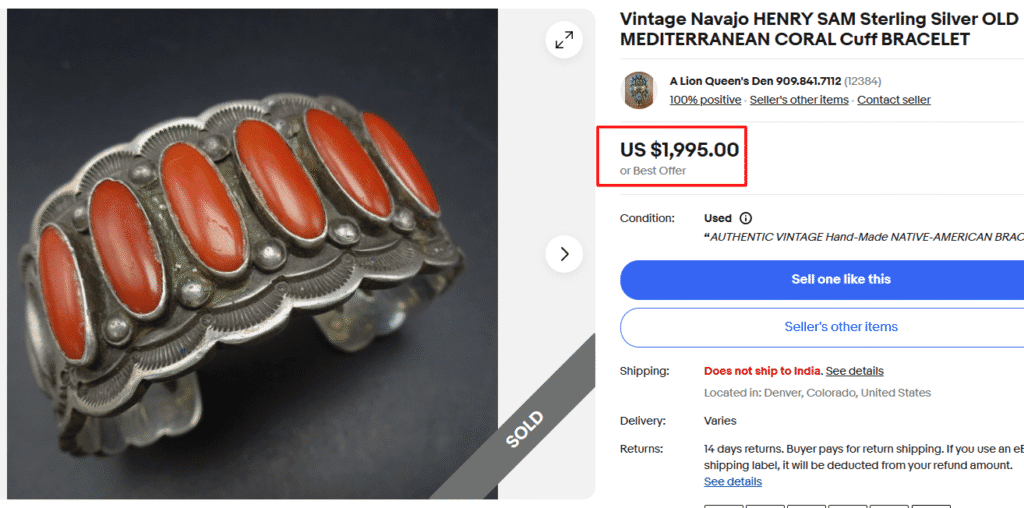
This super rare vintage coral cuff bracelet gives you a glimpse of classic Navajo silversmithing with Mediterranean red coral cabochons. It features six oval stones that are perfectly matched and bezel-set in traditional style.
Hand-made Native American coral jewelry like this became popular in the mid-20th century as trading posts brought coral to Southwestern artisans. The hefty sterling silver frame with museum-quality craftsmanship makes this vintage Navajo coral bracelet worth $1,000-$3,000 or more!
5. Native American Hopi Loloma Style Coral Ring

This vintage coral ring showcases a reflection of Southwest’s rich tradition of coral jewelry making with its Hopi-Loloma style! It features precisely cut red coral segments in geometric patterns arranged in traditional Native designs.
Unlike European cameos, Native American coral pieces like this focus on the stone’s natural beauty rather than carved imagery. That’s why, despite plain coral stones, this piece sold for almost $2,000! The heavy sterling silver frame also added to this value!
6. Victorian 14k Gold Carved Red Coral Flower Necklace

This is a Victorian coral necklace and ring parure featuring intricately carved red coral flowers set in 14k yellow gold. Each coral element is precisely carved to show botanical details, a defining feature of 19th-century artisans’ skills.
The deep red natural coral was particularly prized during the Victorian period, but is quite rare to find today. This set sold for almost $1,800, but the necklace alone can easily fetch $800-$1,500+, depending on the condition and the stone’s preservation!
7. Bacchus Dionysus Gold & Coral Brooch

This historical 22-gram 14k gold brooch features the Roman god of wine carved on coral in exceptional detail. Bacchus imagery was quite popular in Victorian cameos and is considered quite rare today.
The golden-orange coral shows the natural variation, which is prized by collectors — no two pieces are identical. The mythological subject matter, combined with the hefty weight of gold, makes this coral brooch worth $800-$2,500 easily!
8. Tiffany & Co. Gold & Light Pink Coral Necklace
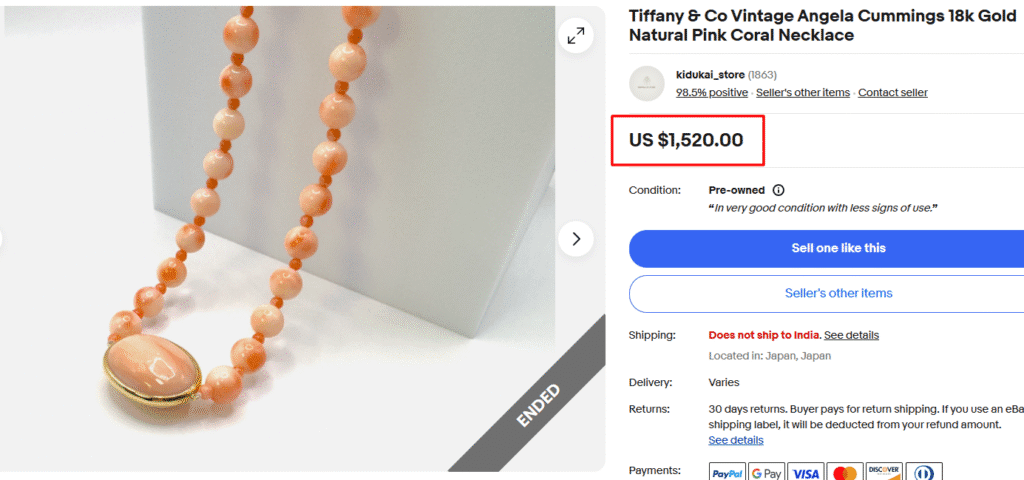
This designer piece comes from Tiffany’s most popular artist, Angela Cummings’ special collection, when she worked there from 1967-1984. It’s a graduated pink coral bead necklace with an 18k frame, a perfect example of Cummings’ signature organic aesthetic!
Authentic Cummings pieces for Tiffany are popular for nature-inspired designs and made her one of the few named designers at Tiffany alongside Elsa Peretti and Jean Schlumberger! No wonder collectors are paying $700-$3,000 for such sleek and elegant pieces!
9. Natural Red Coral Sardinia Beaded Necklace
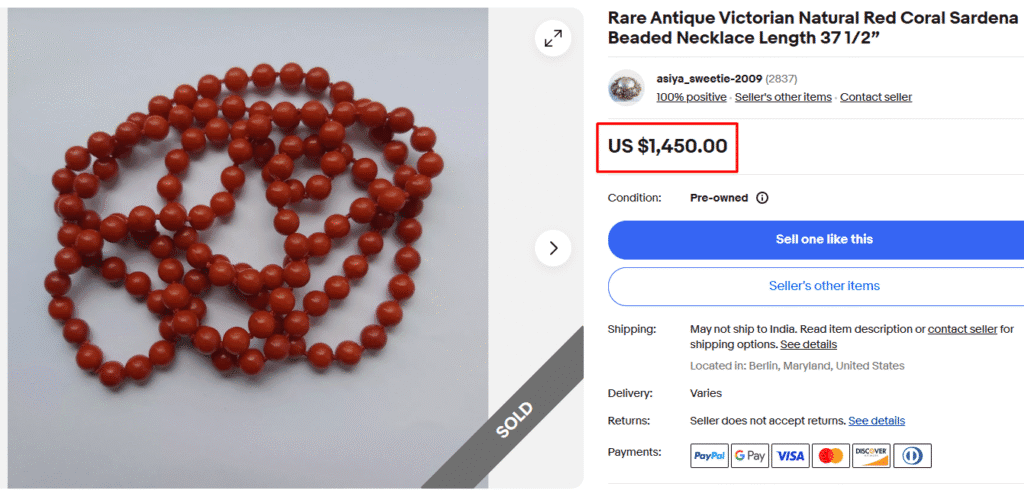
This impressive Victorian coral necklace features the highly collectible Mediterranean red coral from Sardinia! This type of coral is known for its rich tomato-red color that’s completely natural and undyed, making this necklace super valuable (it sold for $1,450!)
You can spot this beaded piece by its uniform round coral beads, displaying the Italian coral craftsmen. Victorian coral necklaces like this were often given as christening gifts and considered protective talismans for children, making them culturally valuable, too!
10. Vintage Carved Rose Coral Gold Pendant
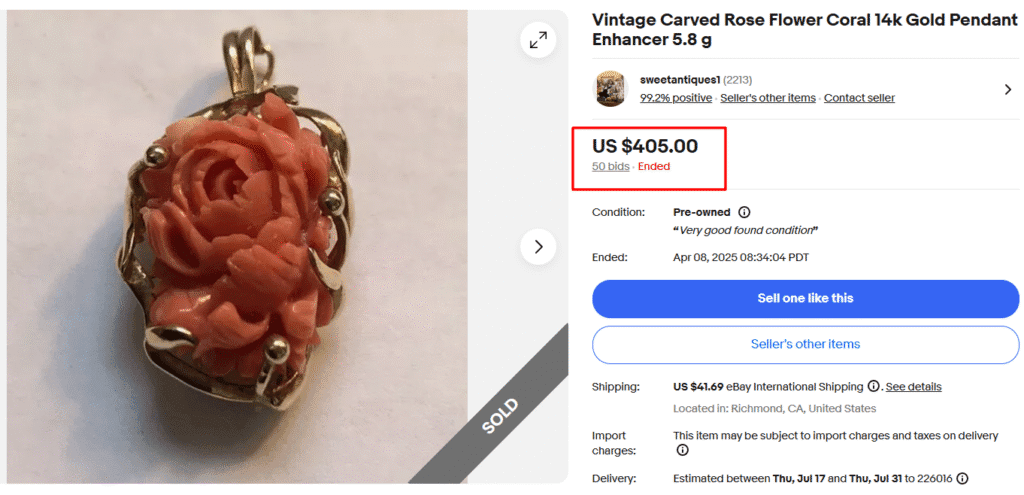
This is an Italian coral pendant from the late 19th century, featuring detailed rose carving on coral with a 14k gold mounting and decorative flourishes, typical of Victorian-era coral jewelry. You’ll always find hallmarks on the back of the clasp/hook on authentic pieces.
The depth of carving in this piece is a true example of the skill required to work with coral’s delicate structure — one wrong move and the piece shatters. Besides, a 14K gold frame also makes it valuable. Larger pendants can even fetch $1,000-$2,000!
11. Edwardian Gold Angel Skin Coral Grape Vine Brooch
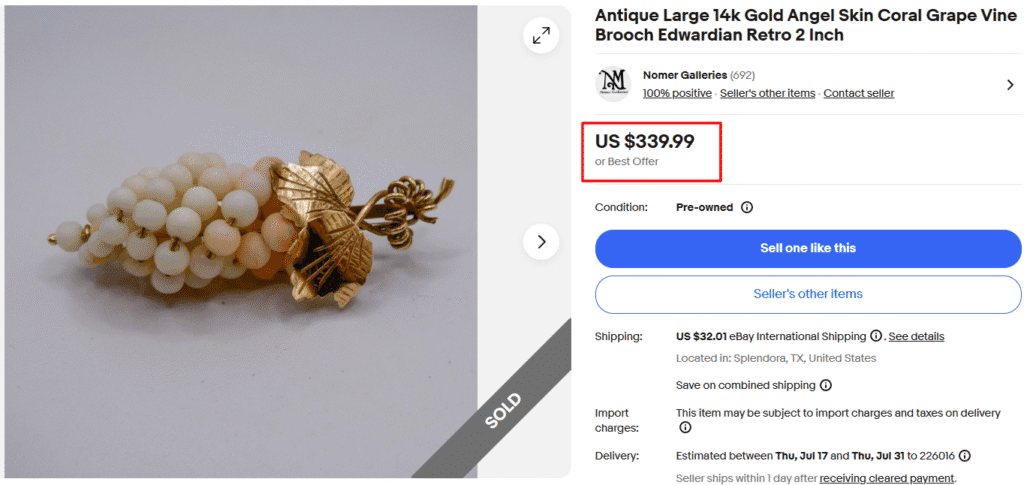
This rare, pretty Edwardian brooch has the coveted “angel skin” coral — the pale pink variety that was especially prized during the early 1900s. The coral grape cluster design is set with detailed 14k gold vine leaves, stems, and engraved leaves.
Angel skin coral gets its name from its delicate blush tone that resembles a baby’s complexion, and it can be really valuable if found in good condition! This specific piece sold for almost $340, but a carved angel skin coral piece can be worth a thousand or more!
How to Identify Real Vintage Coral Jewelry?
Telling real coral from fake can be tricky, especially with some of the convincing imitations out there. Here’s what you need to know.
Coral Types & Characteristics
The first step to identifying real coral jewelry is spotting the type of coral! Basically, there are two main coral types found in vintage jewelry:
1. Red Coral (Corallium Rubrum / Noble Coral)
This type comes mainly from the Mediterranean, especially around Italy and Sardinia. Colors range from light orange-red to that deep “oxblood” red that collectors go crazy for.
The real, precious red coral is dense, non-porous, and takes a beautiful polish. If you look under magnification, you’ll see subtle, wavy growth rings or striations that follow how the coral branch naturally grew, like nature’s fingerprints.
2. Pink Coral (Angel Skin / Pelle d’Angelo)
This coral has those delicate, translucent hues from pale rose to deeper salmon-pink. Most of this comes from Pacific waters around Japan and Taiwan. Angel Skin coral has this smooth, almost porcelain-like look and also shows those subtle growth lines.
Apart from these, you may also occasionally come across these less common types:
- Sardinian Coral: This is high-quality Mediterranean red coral, with the name emphasizing where it came from.
- Momo Coral: This is the Pacific coral with colors from deep pink to orange-red, often in larger pieces.
- Black Coral: This one has rich, dark tones and sometimes shows fine golden-brown growth rings when it’s not polished. This was popular in mid-20th-century jewelry.
- Sponge Coral: As the name hints, this coral is more porous and less dense than precious coral. It’s often dyed to look like red or pink coral. While natural sponge coral can be pretty, it’s generally less valuable because of its texture and all that dyeing.
Color Analysis

Natural coral has this beautiful depth and subtle color variations that you can easily identify it with, even in a single piece. Differentiating between dyed and natural coral is usually pretty obvious once you know how to assess the colors!
For instance, dyed coral often looks unnaturally bright or perfectly consistent. Also, dyed pieces show color fading or dye concentrated in cracks and fissures over time. Sometimes the dye will actually rub off on a cloth.
On the other hand, natural, undyed coral stays the same over the years with slight inconsistencies or “veining.” It needs to feel organic, not robotically uniform.
Quick Tests & Observations
While professional appraisal is always best for valuable coral pieces, here are some quick and safe tests you can do at home to spot a real vintage Coral piece:
- Visual Inspection: Inspect your piece with a jeweler’s loupe (10x magnification)! Natural coral has subtle growth rings or striations. Also, check for minor natural imperfections, tiny pits, or irregularities that prove organic origin. Perfectly smooth and flawless pieces might be fake.
- Touch/Temperature Test: This works because real coral feels cool to the touch like stone and slowly warms when you hold it. Plastic or glass imitations either quickly adapt to your body temperature or feel instantly warm.
- Weight Test: Comparing weights can reveal corals easily, because genuine stones are relatively dense. If it feels unusually light for its size, it could be plastic. Too heavy might mean glass.
- Acetone Test (for dye): This test helps detect artificial coloring. Dip a cotton swab in acetone (nail polish remover) and gently rub an inconspicuous area. If color transfers to the swab, the coral has been dyed. Be careful – strong acetone can affect the polish.
If you’re still not sure of your coral piece’s authenticity, play it safe and get a certified gemologist or antique jewelry appraiser, especially for high-value pieces!
What Makes Vintage Coral Jewelry Valuable?

Real coral isn’t everything when it comes to the value; what makes coral jewelry truly valuable is everything that goes with it – the materials, craftsmanship, and all those little details.
Base Material & Gemstones
The setting of a coral jewelry item matters as much as the coral itself. Here’s how:
- Precious Metals: These make the holy grails of coral jewelry! Vintage coral set in gold (especially higher karats, like 14K or 18K) is easily the most valuable of all! Other metals, like sterling silver or platinum settings, bump up the value considerably.
- Complementary Gemstones: The addition of other precious stones, like Diamonds, sapphire, and pearls, can boost a piece’s worth. Stones like turquoise, onyx, jade, and lapis lazuli, popular in Art Deco or Native American designs, are also highly collectible!
- Craftsmanship of Settings: The artistry in the setting can also enhance the value! Collectors often look for intricate metalwork like filigree, granulation, chasing, or custom-designed settings that perfectly cradle the coral!
Stone Appearance (Size & Shape)
The physical attributes of the coral stone, like the size, shape, and carving quality, play a vital role in its valuation. Here’s how:
Stone Size
Size matters exponentially with coral, not linearly. For example, a 10mm coral bead isn’t just twice as valuable as a 5mm bead – it’s worth many times more. Large matched bead necklaces can hit $10,000 or higher for exceptional quality.
Shape
The shape of the coral stone can also have a direct impact on the piece’s value.
- Beads: These need to be perfectly round, uniform in size, and free of surface flaws. Graduated necklaces, where beads get subtly larger toward the center, are particularly sought after.
- Cameos: These are miniature masterpieces. The value of cameo coral jewelry depends on how sharp the carving is, the level of detail (facial expressions, hair, drapery), and the relevance of the subject (usually classical figures or mythological scenes). Carver signs are a plus!
- Cabochons: These should be smooth, well-polished, and unblemished to be valuable!
- Natural Branch Pieces: These showcase coral in its original form with minimal setting to highlight the organic beauty. The value depends on size, color, and how aesthetically appealing the natural shape is.
Markings & Signs of Authenticity
Marks are not only important for valuation but also for authenticating a vintage jewelry piece. Here are the common marks that matter:
- Hallmarks & Metal Purity Marks: These should be stamped on the metalwork. Look for “750” or “18K” for 18-karat gold and “585” or “14K” for 14-karat gold. Silver pieces must have “925” or “Sterling” for silver. Missing marks aren’t necessarily bad on very old pieces, but clear, correct markings are a plus.
- Maker’s Marks or Signatures: These signs can significantly increase value. Maker’s marks also help identify the jeweler or workshop. Italian master carvers, French jewelry houses, or famous American designers often signed their work, increasing their worth!
- Provenance: Apart from markings, the documented ownership history of a vintage coral jewelry piece can also add immense value, especially for historically significant pieces.
Note: This article is intended for informational, educational, and entertainment purposes only. Some images are illustrative and may not represent actual brands, products, or related entities. All trademarks, product names, brand logos, packaging, and other intellectual property referenced remain the exclusive property of their respective owners. Any brand mentions or references are provided solely for descriptive and educational context and do not imply any formal or commercial association.



